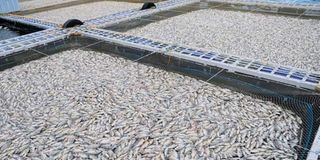Kisumu cage fish farmers refuse to give up despite huge losses

Fishermen in Dunga, Kisumu County counting losses following mass fish death caused by low oxygen.
Even with the huge losses they continue to suffer following the deaths of fish, the cage farmers in Dunga, Kisumu have vowed to soldier on.
Last week, they suffered major losses following the deaths of hundreds of fish, barely six months after a similar incident was reported.
In September 2022, dozens of fishermen who were preparing for harvest incurred losses estimated to be Sh1 billion following the deaths of the aquatic animals.
The farmers have, however, revealed that they are planning to continue taking risks due to a lack of an alternative source of income.
They also claimed that the economic activity has been sustainable enabling them to provide for their families.
“We have not been assured of the security of our fish but we cannot stop. We only have an option of taking risks and hoping for the best,” said Mr Michael Otieno, one of the cage fish farmers.
Mr Otieno further said the venture has also provided the residents from the lake region with an alternative source of fish production to match the growing demand.
The farmers, still reeling from the shock following the latest incident that claimed the lives of thousands of fish in Lake Victoria, also appealed to the government to work on finding a permanent solution to the matter.
“Quitting is not an option for most of us since it is our sole source of livelihood, just like a farmer may suffer losses due to prolonged dry spell, we will also treat our situation as any other challenge,” said Mr Godfrey Ochieng, who has been in the business for the last six years.
First reported case on Monday
The first incident of death was reported on Monday, April 10, with the farmers claiming to have lost over Sh50 million by Wednesday.
According to a report by the Kenya Marine and Fisheries Research Institute (KMFRI), the fingerlings are said to have died after being deprived of oxygen.
Dr Christopher Aura of KMFRI said that there has been increased algae concentration at the cage site which is undergoing decomposition and utilising oxygen in the water causing low levels of dissolved oxygen.
“Thick layer of algal blooming at the site was a sign of increased water pollution whose decomposition may have lowered dissolved oxygen levels, the nets surrounding the cages had also been clogged limiting water circulation,” said Dr Aura.
She added that the fish cages had also been placed in shallow waters below the recommended standards of cage aquaculture which could be between six meters.
Mr Otieno says that over 60 cages of fish fingerlings between the ages of one and six months had been affected.
He said that most of the dead fish floating on the water had turned white and had swollen bellies while those yet to die were gasping for oxygen with open mouths.
The farmers are now appealing to the county government of Kisumu to supply them with fish feeds and fingerlings to kick-start the exercise.
“Most of the farmers have been drained financially and still servicing loans, financial support from the government will however give us the motivation to carry on,” he said.




